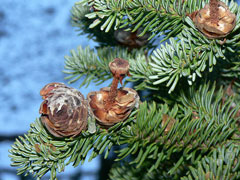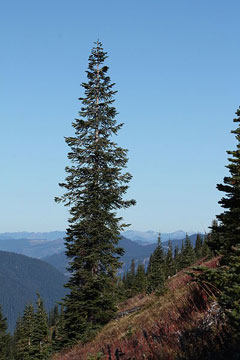 |
|
http://commons.wikimedia.org/wiki/User:Wsiegmund |
 |
|
Translate this page:
Summary
Form: Pyramidal, Upright or erect.
Physical Characteristics

 Abies_lasiocarpa is an evergreen Tree growing to 25 m (82ft) by 4 m (13ft) at a slow rate.
Abies_lasiocarpa is an evergreen Tree growing to 25 m (82ft) by 4 m (13ft) at a slow rate.
See above for USDA hardiness. It is hardy to UK zone 5 and is not frost tender. It is in leaf all year, and the seeds ripen in September. The species is monoecious (individual flowers are either male or female, but both sexes can be found on the same plant) and is pollinated by Wind.
Suitable for: light (sandy), medium (loamy) and heavy (clay) soils and can grow in heavy clay and nutritionally poor soils. Suitable pH: mildly acid and neutral soils. It can grow in full shade (deep woodland) semi-shade (light woodland) or no shade. It prefers moist soil.
UK Hardiness Map
US Hardiness Map
Synonyms
A. subalpina. Pinus lasiocarpa.
Plant Habitats
Edible Uses
The shoot tips are used as a tea substitute[177, 183]. The cones can be ground into a fine powder, then mixed with fat and used as a confection[257]. It is said to be a delicacy and an aid to the digestion[257]. The resin from the trunk is used as a chewing gum[257]. It is said to treat bad breath[257]. Inner bark[257]. No more information is given, but inner bark is often dried, ground into a powder and then used with cereal flours when making bread etc[K]. Seeds[257]. No more information is given, but the seeds are very small and fiddly to use. Seeds of this genus are generally oily with a resinous flavour and can be eaten raw or cooked[K].
References More on Edible Uses
Medicinal Uses
Plants For A Future can not take any responsibility for any adverse effects from the use of plants. Always seek advice from a professional before using a plant medicinally.
Antiseptic[46, 61]. The gummy exudate that appears on the bark was soaked in water until soft and then applied to wounds[213]. An infusion of the resin has been used as an emetic to cleanse the insides[257]. The resin has also been chewed to treat bad breath[257]. A decoction of the bark is used as a tonic and in the treatment of colds and flu[257]. A poultice of the leaves has been used to treat chest colds and fevers[257]. An infusion has been taken to treat the coughing up of blood, which can be the first sign of TB, and as a laxative[257].
References More on Medicinal Uses
The Bookshop: Edible Plant Books
Our Latest books on Perennial Plants For Food Forests and Permaculture Gardens in paperback or digital formats.

Edible Tropical Plants
Food Forest Plants for Hotter Conditions: 250+ Plants For Tropical Food Forests & Permaculture Gardens.
More

Edible Temperate Plants
Plants for Your Food Forest: 500 Plants for Temperate Food Forests & Permaculture Gardens.
More

More Books
PFAF have eight books available in paperback and digital formats. Browse the shop for more information.
Shop Now
Other Uses
The fragrant young leaves and twigs are used to repel moths or are burnt as an incense[46, 61, 169, 257]. They were also ground into a powder and used to make a baby powder and perfumes[226, 257]. A gum is obtained from the bark. It is antiseptic[46, 61] and was chewed by the N. American Indians in order to clean the teeth[226]. It was also used to plug holes in canoes[226]. An infusion of the leaves is used as a hair tonic[257]. The leaves can also be placed in the shoes as a foot deodorant[257]. Wood - light, soft, not strong. It is little used except as a fuel and for pulp[46, 61, 82]. The native North American Indians used it for making chairs and insect-proof storage boxes[257]. It was also used as a fuel and was said to burn for a long time[257].
Special Uses
References More on Other Uses
Cultivation details
Landscape Uses:Screen, Specimen. Prefers a good moist but not water-logged soil[1]. Grows well in heavy clay soils. Very shade tolerant, especially when young, but growth is slower in dense shade[81]. Intolerant of atmospheric pollution[1]. Prefers slightly acid conditions down to a pH of about 5[200]. Prefers growing on a north-facing slope[200]. Occasionally planted for timber in N. Europe[50] but this species does not thrive in Britain[11]. It is a very cold-hardy tree but the milder winters of this country make it susceptible to damage by aphis and late frosts[1, 11, 81]. The sub-species A. lasiocarpa arizonica. (Merriam.)Lemmon. is growing somewhat better here[185]. Trees should be planted into their permanent positions when they are quite small, between 30 and 90cm in height. Larger trees will check badly and hardly put on any growth for several years. This also badly affects root development and wind resistance[200]. Plants are strongly outbreeding, self-fertilized seed usually grows poorly[200]. They hybridize freely with other members of this genus[200]. The crushed foliage has a balsam aroma[185]. Special Features:North American native, There are no flowers or blooms.
References Carbon Farming Information and Carbon Sequestration Information
Temperature Converter
Type a value in the Celsius field to convert the value to Fahrenheit:
Fahrenheit:
The PFAF Bookshop
Plants For A Future have a number of books available in paperback and digital form. Book titles include Edible Plants, Edible Perennials, Edible Trees,Edible Shrubs, Woodland Gardening, and Temperate Food Forest Plants. Our new book is Food Forest Plants For Hotter Conditions (Tropical and Sub-Tropical).
Shop Now
Plant Propagation
Seed - sow early February in a greenhouse or outdoors in March[78]. Germination is often poor, usually taking about 6 - 8 weeks[78]. Stratification is said to produce a more even germination so it is probably best to sow the seed in a cold frame as soon as it is ripe in the autumn[80, 113]. The seed remains viable for up to 5 years if it is well stored[113]. When large enough to handle, prick the seedlings out into individual pots and grow them on for at least their first winter in pots. Plant them out into their permanent positions in late spring or early summer, after the last expected frosts. Alternatively, if you have sufficient seed, it is possible to sow in an outdoor seedbed. One report says that it is best to grow the seedlings on in the shade at a density of about 550 plants per square metre[78] whilst another report says that they are best grown on in a sunny position[80].
Other Names
If available other names are mentioned here
Native Range
NORTHERN AMERICA: Canada (Yukon, British Columbia), United States (Alaska, Oregon, Washington, California)
Weed Potential
Right plant wrong place. We are currently updating this section.
Please note that a plant may be invasive in one area but may not in your area so it’s worth checking.
Conservation Status
IUCN Red List of Threatened Plants Status :

Growth: S = slow M = medium F = fast. Soil: L = light (sandy) M = medium H = heavy (clay). pH: A = acid N = neutral B = basic (alkaline). Shade: F = full shade S = semi-shade N = no shade. Moisture: D = dry M = Moist We = wet Wa = water.
Expert comment
Author
(Hook.)Nutt.
Botanical References
1160200
Links / References
For a list of references used on this page please go here
Readers comment
| Add a comment |
|
If you have important information about this plant that may help other users please add a comment or link below. Only comments or links that are felt to be directly relevant to a plant will be included. If you think a comment/link or information contained on this page is inaccurate or misleading we would welcome your feedback at [email protected]. If you have questions about a plant please use the Forum on this website as we do not have the resources to answer questions ourselves.
* Please note: the comments by website users are not necessarily those held by PFAF and may give misleading or inaccurate information.
To leave a comment please Register or login here All comments need to be approved so will not appear immediately.
|
Subject : Abies_lasiocarpa
|
|
|
|